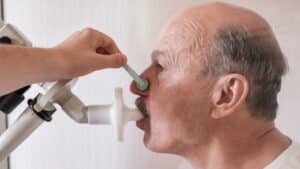For those of us with chronic pulmonary conditions, we may frequently hear our doctors and other people refer to our lung capacity.
With all of the terminology that gets thrown around with a medical condition, sometimes it can be confusing to break everything down.
In this post, we’re going to take a look at what lung capacity is, how it’s affected by pulmonary diseases such as chronic obstructive pulmonary disease (COPD) or pulmonary fibrosis, and what you can do to increase your lung capacity.
What is Lung Capacity?
Total lung capacity, or TLC, refers to the maximum amount of air that your lungs can hold. Typically, men have a greater lung capacity than women.
At rest, a man’s lungs can hold about 1.5 pints of air, while a women’s lungs can hold around 0.6 to 0.8 pints. However, most of us do not use our full lung capacity.
According to Jonathan P. Parsons, M.D., professor of internal medicine, associate director of Clinical Services, and director of the Division of Pulmonary, Allergy, Critical Care and Sleep Medicine at the Ohio State University Asthma Center, “The lungs are over-engineered to accomplish the job that we ask them to do.
In healthy people without chronic lung disease, even at maximum exercise intensity, we only use 70 percent of the possible lung capacity.”
Why is Lung Capacity Important?
Lung capacity predicts health and longevity. A 29-year study published in Chest concluded that lung capacity is a long-term predictor of respiratory mortality and should be used as a tool for general health assessment.
Because of this, people with chronic pulmonary conditions should pay particular care to monitor lung capacity. Taking spirometry tests is a good way to measure lung function.
A spirometry test takes several measures, such as how much air you can exhale in one second, called an FEV1 score, or forced expiratory volume in 1 second.
Our lung capacity naturally declines with age, starting at age 30. By the age of 50, our lung capacity may be reduced by as much as 50 percent.
This means that the older you get, the harder it is for your lungs to breathe in and hold air. When we breathe in less oxygen, our body and cells also receive less oxygen, forcing our heart to work harder to pump oxygen throughout the body.
The heart working overtime long-term can lead to heart failure. Earlier symptoms of reduced lung capacity include shortness of breath, decreased stamina and reduced endurance, and frequent respiratory infections.
How is Lung Capacity Affected by COPD?
COPD affects the quantity of air that can move in and out of your lungs.
The more advanced the COPD is, the harder it is for your lungs to breathe in and to exhale air. The more severe the stage of COPD, the lower the lung capacity and function.
However, lung capacity and lung function are not the same.
While lung capacity refers to the maximum amount of air that your lungs can hold, lung function refers to how quickly you can inhale and exhale air from your lungs and how effectively your lungs both oxygenate and remove carbon dioxide from your blood.
Both lung capacity and lung function are affected by the various stages of COPD.
There are four stages of COPD: mild, moderate, severe and very severe. Here is a breakdown of the different stages of COPD based on FEV1 score:
- Mild COPD: 80 percent or higher
- Moderate COPD: 50-70 percent
- Severe COPD: 30 to 49 percent
- Very Severe COPD: Less than 30 percent
Can I Improve my Lung Capacity?
Yes! Lung function cannot be improved; however, lung capacity may be improved. Remember always to follow the advice and guidance of your doctor.
Here are five easy steps for increasing lung capacity.
1. Take More Vitamin D
Some studies show that of those who increase their intake of Vitamin D in conjunction with standard rehabilitation, many show improvement in their ability to exercise and in respiratory strength.
Vitamin D helps reduce inflammation, which is a key issue for people with COPD.
2. Increase Your Self-Confidence
Several people with COPD participated in an exercise study, which found that those who underwent a confidence-boosting program before starting the exercise routine experienced better results.
Exercise is essential for people, and taking that one step further, having self-confidence improves your ability to exercise.
3. Keep a Clean Home
Dust and other allergens can cause more frequent flare-ups. Support your lungs by keeping your home as clean as possible. Consider removing items that collect dust from your homes, such as curtains and tablecloths.
Wash your sheets at high temperatures, and dust and vacuum regularly. Indoor air purifiers are another great way to improve the quality of air inside your home.

4. Exercise More
Each time you exercise, you improve your exercise tolerance level. Start slow, and be sure to check with your primary care physician before starting a new exercise regime.
Simply walking in place while watching TV or walking around the block is a great place to start.
5. Practice Breathing Exercises
Breathing exercises are a great way to help your lungs. Start in a relaxed posture so you’re able to breathe in and out more easily.
Read Best Breathing Exercises for COPD for some great breathing techniques to try out.

Christine Kingsley, APRN is the Health and Wellness Director at the Lung Institute where she focuses on providing helpful online resources for people looking for information on various lung diseases, breathing exercises, and healthy lifestyle choices. She advocates for holistic care that involves working with your doctor to explore all options including traditional and alternative care while focusing on diet and exercise as proactive measures.









